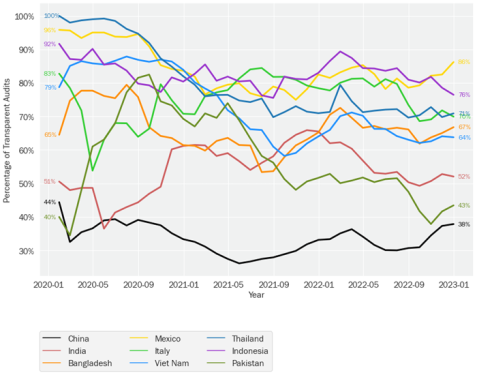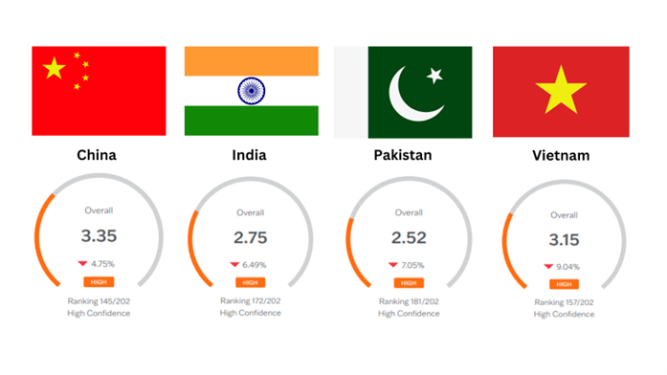Supply Chain Transparency is Declining: Does this Increase the Risk of Human Rights Violations?
Supplier transparency is dropping worldwide. Whether driven by a pressure to maintain production reliability, or just residual from a rise in remote audits or Covid-19, this decline is part of a trend that we have seen over the course of the past five years towards poorer visibility into supplier practices. This downwards trend complicates program management: when transparency is poor, so too is our ability to identify the highest risk parts of a supply chain.
Suppliers in at least 50 sourcing geographies were less transparent this year than last. While countries like China and India have historically shown lower transparency rates, others like Vietnam and Pakistan are beginning to reflect similar patterns. This issue has been most prominent in Asian countries, which have consistently been classified as “higher risk” for supply chain ESG violations in ELEVATE’s biannual risk ratings. We have also seen transparency risks increasing in countries like Italy and Mexico.
Transparency Rates Across Key Sourcing Regions: Rolling 6-month Average

A sharp decline in supplier transparency across most sourcing markets happened during the Covid-19 pandemic, when factories were under significant production time / cost pressures and on-site audits were sometimes replaced by less rigorous remote assessments and SAQ’s. Levels of transparency continue to drop in 2023. (Source: ELEVATE, 2023)
When examining the countries with lower transparency rates, such as China, India, Pakistan and Vietnam, we see patterns in their inherent supply chain ESG risk rating: each are classified as “High Risk.” If suppliers in higher risk countries are engaging in falsifying or hiding data, the risk of businesses unknowingly being tied to inhumane practices becomes far greater. This can ultimately lead to continued exploitation of workers, environmental harm, and reputational damage for companies that lack visibility over these suppliers.

EiQ risk profiles give insight into the overall risk ratings for countries linked to lower transparency rates. (Source: ELEVATE, 2023)
Why the lack of transparency?
Suppliers are identified as non-transparent when they misrepresent or withhold information (typically about wages and working hours) from auditors during assessments. Non-transparent suppliers sometimes coach their employees ahead of interviews to conceal malpractice. This can occur because:
- Tight production deadlines and turnaround times may lead to excessive working hours.
- Low margins linked to corporate buying practices may motivate suppliers to cut costs.
- The use of “one-size-fits-all” industry scheme audits may cause suppliers to conceal issues for fear of facing penalties from buyers or losing business. This approach can discourage suppliers from being transparent about their challenges and non-compliant practices during audits.
As a result of the above, many suppliers underreport the numbers of weekly hours worked by their employees and the number of consecutive working days, while also overreporting the percentage of workers paid correctly, according to ELEVATE data.
Audit data is the key component to a robust / reliable responsible sourcing program. Without high quality data, risk assessments and monitoring cannot be effective. Improving supplier transparency not only optimizes risk management, but it can also strengthen business relationships by fostering a greater degree of trust and collaboration and enhancing supplier performance. Businesses can more effectively assess their capabilities and make data-driven decisions to optimize their supply chains. This can lead to improved product quality, better on-time delivery, and increased efficiency.
To address misrepresentation during audits, companies and auditors need to take a more proactive and comprehensive approach to assessments. This may involve (a) conducting more frequent and rigorous audits (b) focusing on high-risk suppliers and (c) engaging in semi- or unannounced visits. Companies can also work with suppliers to develop sustainable and ethical practices that go beyond mere compliance with legal requirements. With social compliance and ESG under increasing scrutiny, turning a blind eye to potential holes in transparency can be detrimental. Not only is consumer trust at stake, but brand reputation, government penalties, and long-term sustainability are all on the line.
Companies increasingly rely on suppliers located in different countries and regions to source their materials, components, and finished products. This complex network of global supply chains further exacerbates the need for supplier visibility and trust, especially for those beyond the first tier of production. Collectively this makes putting supplier transparency at the center of all program design even more crucial.
These blogs are written by ELEVATE staff members or associates and the views and opinions expressed are not necessarily those of ELEVATE.
About the author
